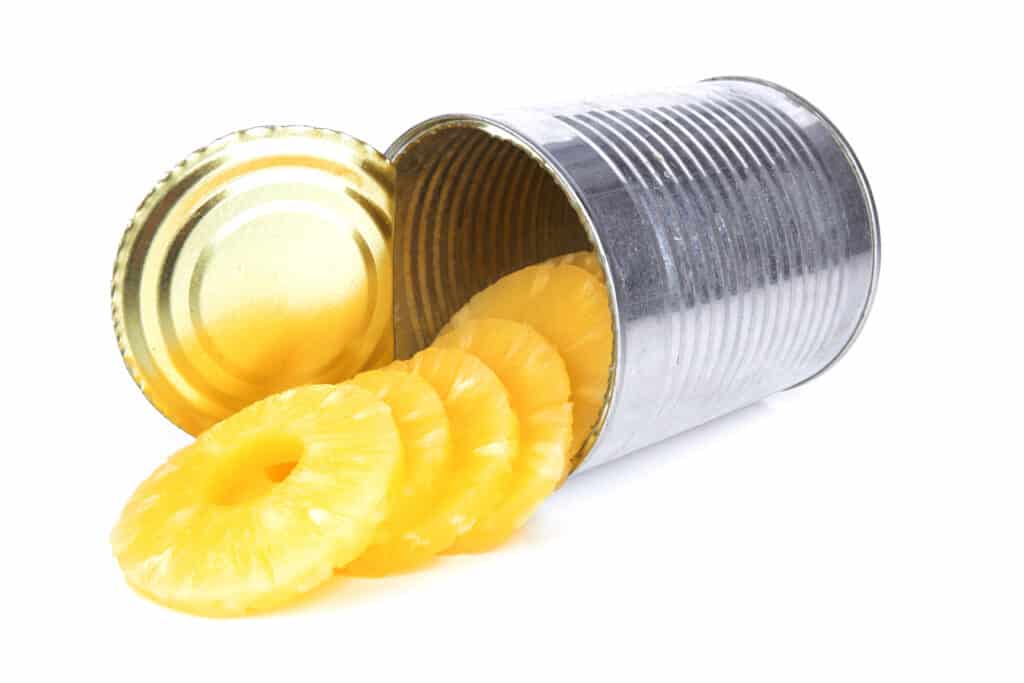Pineapple, the tropical fruit beloved by many, is a sweet and tangy treat that may attract the wandering eye of your furry best friend. As they beg at your side for a taste, those wondering whether or not dogs can eat pineapple will be happy to know that, in moderation, the tropical fruit makes for a healthy and nutritious dog treat.
Read on to learn more about dogs, pineapple, and what to know before giving a slice to your best friend.

Pineapple is a delicious
nutritious dog treat!
©Tim UR/Shutterstock.com
Can Dogs Eat Pineapple?
Yes, raw pineapple, in moderation, provides an excellent snack for puppies, similar in nutrition quality to strawberries and melons. A few large chunks of pineapple, peeled and sliced into bite-sized portions, are an adequate serving size for most dogs. Frozen pineapple makes for an incredibly satisfying summer treat, helping keep pups cool when the weather is warmer.

A few large chunks of pineapple, peeled and sliced into bite-sized portions, are an adequate serving for most dogs
©iStock.com/Saksoni
However, you should never feed canned pineapple to your pup. The preservatives and syrup added to canned fruit, such as pineapple, contain high levels of sugar that aren’t good for dogs’ digestion. Too much can lead to weight-related problems such as obesity and diabetes.
Is Pineapple Good for Dogs?
Raw, fresh pineapple contains high levels of vitamin C, riboflavin, niacin, vitamin B6, and many more micronutrients essential to any dog’s diet. Pineapple also supplies manganese, copper, magnesium, calcium, potassium, zinc, and iron. These minerals play a role in various physiological functions ranging from joint health and immune function to energy levels and mood in humans and dogs. The impressive catalog of pineapple’s enzymes, vitamins, minerals, and healthy carbohydrates make it a natural addition to any pup’s diet.
What to Know Before Feeding Your Dog Pineapple
While pineapple’s long list of essential vitamins and nutrients positions it as an excellent snack for dogs, there are vital things to consider before passing a few bites on to your pup. Pineapple contains high fiber and fructose, a naturally occurring sugar in fruits and vegetables. While the fruit is a healthy treat in small amounts, high levels of fiber from pineapple can disrupt your dog’s digestive system, potentially causing diarrhea or other symptoms of an upset stomach, such as bloating and gassiness.
If your dog overindulges in pineapple, monitor them for signs of discomfort, diarrhea, or other unusual reactions. These signs may indicate that pineapple isn’t the best fruit snack for their metabolism. Also, the pineapple’s tougher core, as well as its spiny skin, is harder to digest, potentially resulting in a bowel obstruction. Only feed your dog the fleshy, tender portion of the pineapple to stay on the safe side.
How to Feed Your Dog Pineapple
Start with Small Quantities
New foods of any type can upset your dog’s stomach if they’re not used to them, especially when served in large quantities. Due to pineapple’s high fiber content, too much tangy fruit can cause discomfort and potentially lead to digestive issues such as diarrhea. To prevent this from happening, keep portions on the small side, initially, or consider adding probiotics or pumpkin in their diet, which aid digestion.

As with any new food, start small to see how your dog reacts.
©Kseniya Resphoto/Shutterstock.com
Be aware of pineapple’s sugar
Pineapple contains fruit-derived sugars that most dogs can eat. However, if your dog is generally sensitive to sweet fruit, they probably won’t respond well to pineapple. Dogs with blood sugar issues such as diabetes may also be susceptible to pineapple’s sugar, so be sure to consult your vet before feeding them any.
Avoid canned pineapple
Canned pineapple typically includes added preservatives and extra sugar or sweeteners with unnaturally high level of sweetness. These additional ingredients are unhealthy for dogs, and too much sugar can lead to more severe digestive and weight-related issues. For the same reasons, avoid giving store-bought pineapple juice to your pup.

Never feed your dog canned pineapple.
©Sergiy Kuzmin/Shutterstock.com
Remove the core and skin
Remove the core and the skin of the pineapple before sharing with your pup. The tender, fleshy part of the pineapple is the only part that dogs (and humans) should eat. Due to its high fiber content, the pineapple’s core is too tough to digest and can upset your dog’s stomach.
You can buy pre-cut, prepared, fresh pineapple chunks from your grocery store, but even these pieces are still usually large. Cut the pineapple into bite-sized portions before giving your dog a small amount. You can consult your veterinarian to know the correct amount for your dog’s size, age, activity level, and overall health.
How much pineapple can I give my dog?
Pineapple should constitute no more than 10% of your dog’s diet. The rest should be devoted to regular dog food, whether it’s kibble or a veterinarian-approved human food recipe made from scratch. Typically, two to three small bites of pineapple per day is plenty.
We recommend sparing indulgence with the treats, but when appropriately prepared, pineapple makes for a delectable and nutrient-rich snack for dogs. Stick the fleshy bits in the freezer or share a few fresh pieces with your pup, resting assured that the treat is a welcome and healthy addition to their diet.
Up Next
The photo featured at the top of this post is © OlesyaNickolaeva/Shutterstock.com
Ready to discover the top 10 cutest dog breeds in the entire world?
How about the fastest dogs, the largest dogs and those that are -- quite frankly -- just the kindest dogs on the planet? Each day, AZ Animals sends out lists just like this to our thousands of email subscribers. And the best part? It's FREE. Join today by entering your email below.
Sources
- a-z-animals.com, Available here: https://a-z-animals.com/blog/which-fruits-are-safe-for-dogs-to-eat/
- pubmed.ncbi.nlm.nih.gov/, Available here: https://pubmed.ncbi.nlm.nih.gov/19386005/
- sciencedirect.com, Available here: https://www.sciencedirect.com/science/article/pii/S0021925818749922?ref=cra_js_challenge&fr=RR-1
Thank you for reading! Have some feedback for us? Contact the AZ Animals editorial team.






